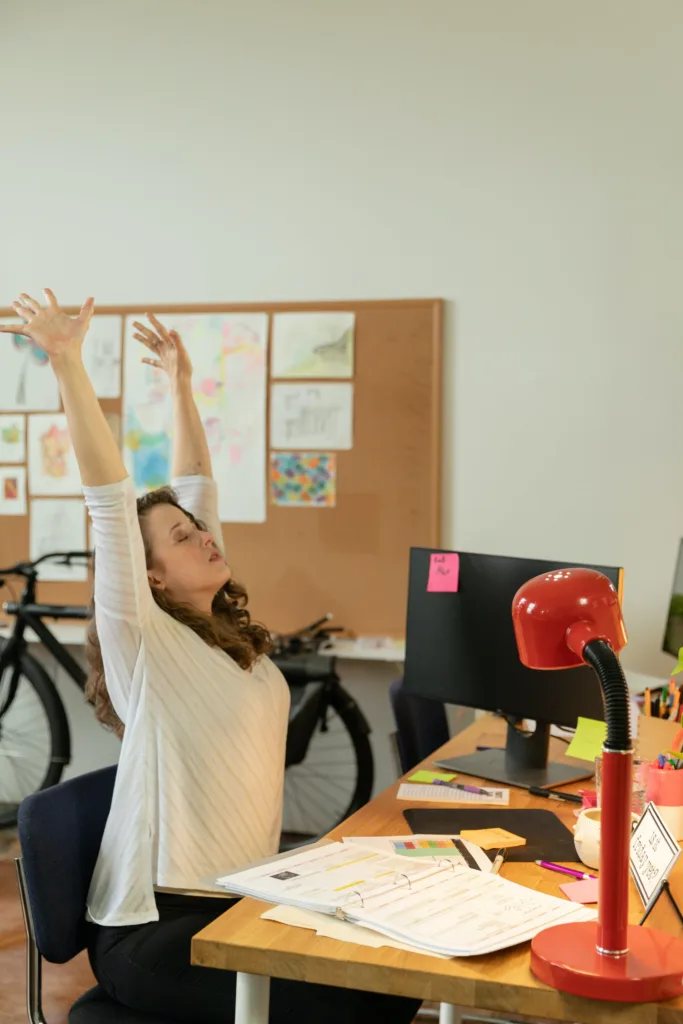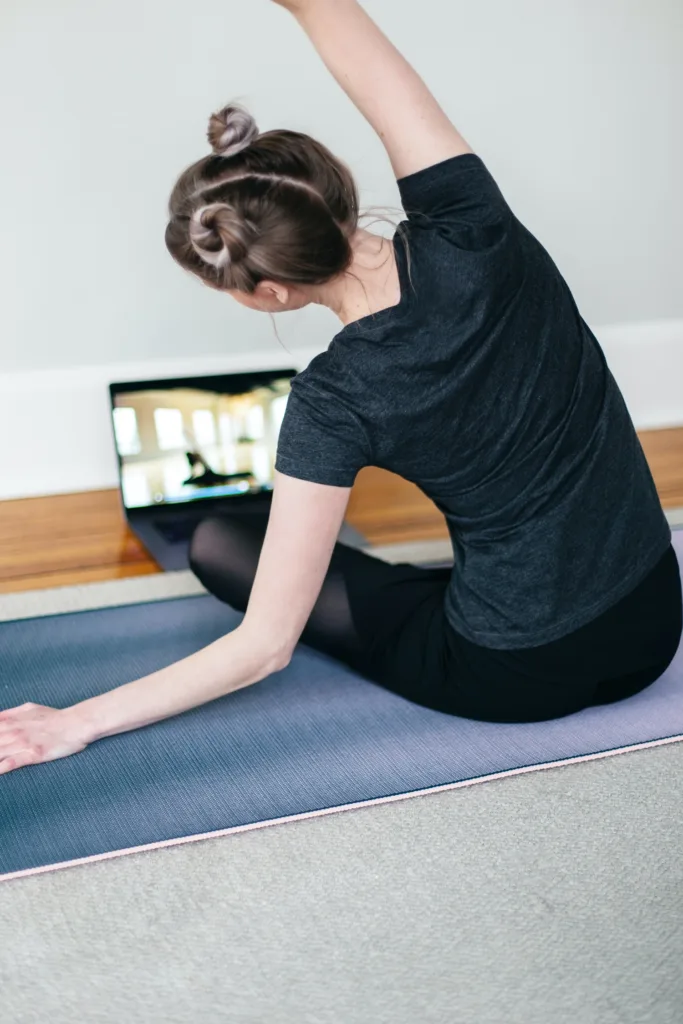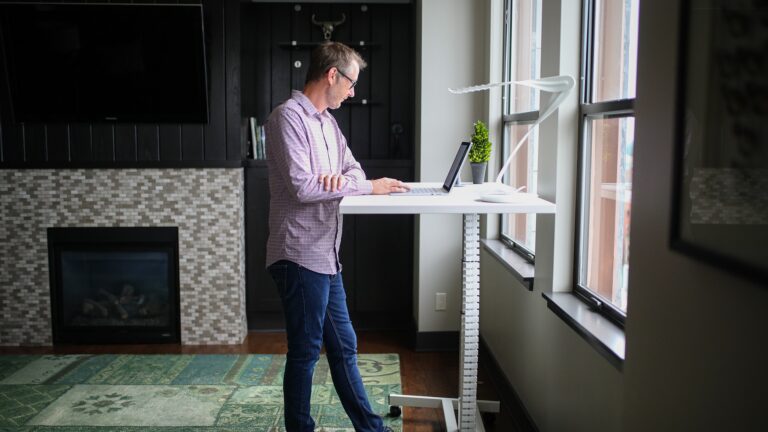In the last few years, working from home has become the reality (and the norm) for many people around the world. Although it may seem like a great arrangement – avoiding the morning commute, preventing early mornings and being able to take meetings and calls from anywhere, it has the potential to lead to a sedentary lifestyle.
According to a survey conducted by the Royal Society for Public Health, 45% of those polled felt that working from home was better for their mental and physical health and wellbeing. However, 46% of people who had switched to working from home following Covid-19 had reported being less active and taking less exercise. Also, women in particular were more likely than men to develop musculoskeletal problems.1
If you don’t move your body when working from home, and avoid taking regular breaks to exercise, staying in one place for too long can be bad for your health. With a little discipline and a good routine, it’s possible to find the ideal balance of working from home and taking exercise. Here’s how to get moving and fit in some exercise when working from home.
Why it’s important to stay active when you work from home
Working from home can be enjoyable for many, but staying active is important to ensure that you stay fit and healthy. Sitting down at a desk for hours on end, and then walking to the sofa or to your bed, day after day, can soon take its toll on your health and posture. Prolonged sitting can also lead to health problems such as musculoskeletal disorders, obesity, cardiovascular diseases and a lack of overall fitness.
Staying active can also help mental health, and can aid productivity during the working day, as well as reducing the risk of work-from-home fatigue. A quick walk or workout during the day can release endorphins that boost motivation and lower stress levels, which is important to do when working from home in a more isolated environment.
An improved work/life balance
According to The Home Office Life, 78% of people who work from home claim it gives them a better work/life balance.2 Staying active while working from home is important to keep this balance even, because there’s always a risk that work can spill over into other areas of your life.
If you work at home often, your personal and work spaces may become intertwined, especially if you have a smaller living area like a flat or apartment, and don’t have an extra bedroom that you can designate as a sole office space. Taking breaks to exercise or doing a quick work-from-home workout can give you that mental separation between life and work, helping your mind to relax and step away from being in ‘work mode’.
Feeling more productive
Working from home can feel more challenging in the winter months, leading to a sense of lethargy. If you take part in frequent exercise, or go for a walk in the middle of your day, it can help you to stay active and alert, which in turn will give you more energy throughout working hours.
Working out when doing remote work is important because it’s far easier to snack when working remotely, and not having a physical commute can mean less activity like walking, cycling and so on. Frequent exercise helps the body maintain a healthy metabolism and weight by burning calories, which becomes even more important if you are living and working in the same space.
According to the National Institutes of Health, the average person burns just 134 calories sitting in an hour, whereas they burn 296 calories taking a brisk walk (on something like a commute).3
After 20 minutes of sitting down, it’s a good idea to get up, stretch and move more – even if it’s for just a couple of minutes. You can set a reminder on your phone or watch to get you to do this.
Remote working can also come with its own stressors, so getting up from your desk frequently can promote stress relief and help you to clear your mind, so that you return focused and ready to continue working. You’ll also notice improvements in your sleep if you take part in regular physical activity, which can improve your quality of life and long-term health.
Preventing isolation
According to Startups Magazine, 53% of remote workers feel isolated from team meetings and office events.4 If you take time from your remote working schedule to join an exercise class in the evenings, or go for a run in your local area, it can give you an opportunity to meet people and provide a sense of community. This can help to combat the mental feelings of loneliness that some people can feel in working from home.
Ideas to keep you active when working from home
While it may seem like staying active can be more of a challenge when working from home, there are plenty of ways to incorporate daily movement into your everyday routine quickly and easily. Staying active as a remote worker doesn’t necessarily mean spending a long time at the gym, or getting up at 4am to exercise. Here are some work-from-home exercise ideas you may like to try:
1. Making a home office gym
If you’ve got the room to spare, set up a space in your home where you can work out during the day for 15 minutes or so. This could include equipment like weights, a yoga mat, an exercise bike, resistance bands and so on. This way, when you need some downtime during the working day, you can take part in a quick workout quickly and easily to burn a few more calories.
2. Have a standing break
The NHS advises that we take at least 150 minutes of exercise per week. Being inactive and sitting for long periods of time has been linked to obesity, premature death and type 2 diabetes.5 When working remotely, take stretches as often as you can, including squats and raising your calves to engage leg muscles. Consider the pros and cons of sitting and standing desks and be sure to strike a balance between the two during the work day.
3. Stand up during meetings
If you’re often on video calls to take meetings, stand up while you take them. In the summer months, it’s even better to take your laptop outside into the fresh air and stand up to keep your mind and body refreshed. Remote stand-up meetings can help improve productivity as well as make you a little more active during the day.
4. Do desk exercises
Desk exercises are quite similar to the exercises you can do on a long-haul flight. Make circles with your ankles, stretch out your legs, do squats, seated bicycle kicks or push-ups. All of these exercises help promote blood flow and counter the effects of sitting for long periods. Check out our guide to standing desk exercises you could try.

5. Use an exercise ball as your chair
This one’s great for toning your core and improving your posture. Sit on an exercise ball rather than your desk chair for 20-30 minutes. Doing this type of balance work will require your body to make small adjustments, helping you to stay active.
6. Stretch and do yoga
Including yoga or stretches into your daily routine will help boost serotonin levels, while working your muscles and improving blood flow. Stretching and doing yoga can also help to awaken the mind and soul when you need a motivational boost.
7. Do a mini cardio workout
Run up and down the stairs a few times, try jumping on the spot for a minute, or use a skipping rope out in the garden. These are just a few ways to get your heart pumping while working your whole body.
Short bursts of activity are great for maintaining fitness levels. You can also try planks, jumping jacks, burpees or sit-ups. By doing a quick cardio session, you can boost your productivity and energy levels quickly.
8. Take a dance break
Put on your favourite song and have a dance break in your office away from your desk. It’ll take away any stress, improve your mood and is a great way to keep active.
9. Head outdoors on your lunch break
Spend your lunch break outside if you can to get some fresh air and to reset your mind. This is especially important when the weather is cold in winter, and daylight hours are short. Go for a walk outside, go cycling, or for a run to keep fit and healthy. If you have a garden, try to spend as much time in it as you can to aid mental health.
10. Use a standing desk
Standing desks are great for alternating between sitting and standing throughout the day. Your posture gets better, and your body burns more calories. You can use a standing desk that is adjustable so it’s suitable for both sitting and standing.
11. Try a virtual workout
After your day working from home, try a virtual workout through a workout platform. Classes can be scheduled to fit around your working hours, and many platforms offer a large selection of workout activities.

12. Replicate your daily commute
Before starting work, instead of sleeping in and getting to your desk in your pyjamas, replicate the activity you’d usually do as part of your daily commute. Cycle around your local neighbourhood, or have a walk either before or after work.
References
- https://www.rsph.org.uk/about-us/news/survey-reveals-the-mental-and-physical-health-impacts-of-home-working-during-covid-19.html
- https://thehomeofficelife.com/blog/work-from-home-statistics
- https://www.startstanding.org/calculate-calories-burned-sitting-vs-standing/
- https://startupsmagazine.co.uk/article-how-employers-can-prevent-remote-workers-feeling-excluded





